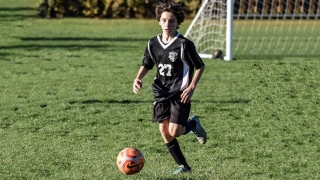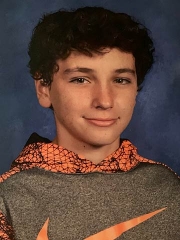Brian’s Story: Getting Back to Sports – Safely
Published on
Published on
When he was just a few weeks old, Brian was diagnosed with coarctation of the aorta, which is when the aorta (the main artery that carries blood out of the heart to the body) is too narrow and greatly reduces blood flow to the lower body. His aortic valve also had only two flaps instead of three (known as a bicuspid aortic valve), further restricting blood flow. If left untreated, Brian’s heart could fail to pump blood properly, leading to damage to the organs in the lower body.
Brian underwent surgery as an infant, and for years, the family managed his condition through medication and avoiding high-contact activities. But it wasn't until they started working with doctors at Children’s Hospital of Philadelphia (CHOP) that Brian’s mom, Deanna, and Brian, now 14, felt they could instead control it.
 Almost immediately, Deanna knew something was off.
Almost immediately, Deanna knew something was off.
She gave birth to her fourth son, Brian, in 2008. At the time, Deanna had been a nurse for 10 years — four them in pediatric intensive care. Now a mom of four, it didn't take long for her to see that her newborn son wasn't as healthy as she had hoped. Every once in a while, he'd start breathing fast — up to 80 times a minute. Once, Deanna looked over at Brian in someone else’s arms, and his entire foot was deep purple.
Deanna took her son to the cardiologist, where Brian’s heart condition was diagnosed.
"It was terrifying," says Deanna. "His diagnosis started one of the hardest months my family has ever gone through."
Brian had also contracted RSV (respiratory syncytial virus), which further intensified his heart complications. Under any other circumstances, doctors would have rushed him to surgery, but instead, Brian spent four weeks in the hospital while doctors waited for the virus to clear his system.
"We wanted to give him every chance of having as normal a life as possible growing up – and that's exactly what this surgery did," says Deanna. "But still, there were always things we had to keep in the back of our minds – checkups, medications. We knew there would be certain activities he could never do, like wrestling and football, but we were ok with that."
 For years, Brian was cared for at the hospital where Deanna used to work, and the family managed his condition through medication and avoiding high-contact activities. But as his care team began to transition, the family made the decision to seek care at CHOP. It wasn't until that change that Deanna and Brian felt they could instead take control of Brian’s heart condition.
For years, Brian was cared for at the hospital where Deanna used to work, and the family managed his condition through medication and avoiding high-contact activities. But as his care team began to transition, the family made the decision to seek care at CHOP. It wasn't until that change that Deanna and Brian felt they could instead take control of Brian’s heart condition.
"From the start, I was immediately impressed with CHOP," says Deanna. "Their bedside mannerisms were always focused on Brian. They treated him like a person while explaining things in a way a child could understand."
Sometimes, that meant hard conversations. Brian loved to play sports and run around with his friends. Deanna didn’t want to limit him, so she worked with cardiologist Matthew Elias, MD, to keep a close eye on his activities and risk level — including time on the school soccer team and a short stint in karate.
When Brian turned 13, Dr. Elias thought it might be best for Brian to leave soccer behind. This was around the age kids get more serious about their sports, he said, which meant a higher risk of collision. But Deanna wasn't as sure – Covid restrictions had recently lifted, and she was hesitant to take Brian away from the team immediately after they started back up.
“Dr. Elias listened to me as a parent, not just as a patient," she says. "Brian had been isolated for more than two years – he needed this. We weighed the risks and benefits and decided that the social benefits of being on the team outweighed the risks."
Brian played through the next season but agreed he would discontinue soccer after 8th grade, before joining the high school team, which plays at a higher intensity.
"When that time came, Brian was old enough to fully understand his medical condition and make informed decisions on his own. He felt like he had control over leaving the sport, not that he was pulled away from it," says Deanna.
Just because soccer didn’t work out didn’t mean there wasn’t another option for Brian. CHOP doctors came up with a new plan, thanks to the hospital's new Sports Cardiology Clinic, which provides individualized care and recommendations to promote safe and effective exercise in athletes with cardiac disease.
"We took the train into the city and settled in for a day of testing," says Deanna. "It felt warm and comfortable, which meant Brian could actually have fun while there, not feel like he had wasted his day at the doctor's."
Brian first went to the Cardiovascular Exercise Physiology Laboratory, the largest of its kind in the country, which provides diagnostic testing and rehabilitative services to patients with congenital and acquired heart disease. There, Brian met with Jonathan B. Edelson, MD, and others in the clinic. He completed many physical tests, like exercising on a bike, and discussed his activity goals.
“Even with small things, they made it a collaborative process,” says Deanna. “At one point in the testing, Brian wanted to show he could do pushups, but the doctors felt it would put too much strain on his heart. They didn’t just say, 'No, you can't do that.’ They let him do a pushup, then showed him how it restricted him from breathing, which put pressure on his heart. They explained everything in a way that helped him understand the 'why' behind the restriction."
Brian is small, in the bottom 3% of weight for his age, so doctors also gave him information – from specific foods to safe exercises – on how to bulk up his body without potentially putting his heart at risk.
"Because he's so small, body image and growth are really important to him," says Deanna. "Especially as he's getting older, body image is going to become a much bigger concern. Now, instead of making him feel like he can’t gain muscle through exercise, he can work with his care team to find ways to gain muscle safely.”
Among other key information, Deanna and Brian found that Brian has an excellent oxygen-carrying capacity – perfect for a cross-country runner.
“They didn’t focus on what he can't do – they gave him alternatives specifically geared toward his strengths," says Deanna. "It wasn't, 'Here's something safe for kids like you.' It was, 'Here's something you're uniquely good at where you can really excel.'"
Instead of feeling sad for what he lost, says Deanna, Brian was excited to try something new.
"Encouraging him was a way to let him come to his own conclusions about what he wants to do and what he's capable of," she adds. "It let him take back control. As a mom, I just feel grateful that I can get the best care for my child at CHOP."